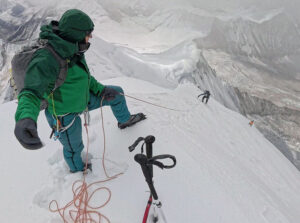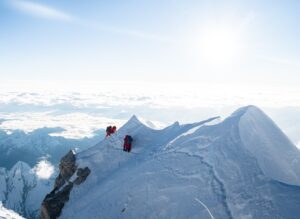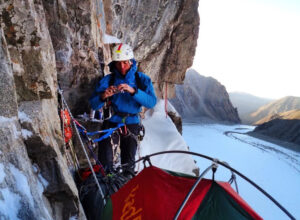On Saturday morning, we sent Alex Txikon some questions about his recent winter ascent of Manaslu. Near midnight, we received his audio responses. The Basque climber recalled the ascent, including some technical details about strategy, style, and the last part of the summit ridge.
We also followed up with more questions for him, about summit evidence and an accident that occurred during the descent. Here is what Alex Txikon told us.
Like a little Khumbu Icefall
“Good conditions but more difficult and dangerous than I had expected, especially between Camp 1 and Camp 2, due to extremely tricky passages among seracs, like a little Khumbu icefall,” Txikon said.
How much rope did they fix as they went up?
“Until Camp 1, we fixed some 100m of rope, plus 600m more in the exposed sections between Camp 1 and Camp 2,” he said.
They also fixed some 900m between Camp 3 and Camp 4, and no rope at all from Camp 4 to the summit.

On Manaslu’s lower slopes in high winds.
Timing
“I can’t really tell the exact timing, I climbed without a watch,” Txikon admitted. However, he ventured an estimate, helped by his partners and the Base Camp team:
“The total ascent time was some 60 hours. We left Base Camp on Jan. 4 between 7 and 8 am. Simone [Moro], Chhepal [Sherpa], and I arrived in Camp 2 seven hours later, and the others [came afterward],” he recalled. “On Jan. 5, we all moved to Camp 3.”
For the final summit push, they set off from Camp 3 sometime between 10:15 and 10:45 pm on Jan. 5, Txikon recalled. “We arrived at the summit at around 9:30 am [on Jan. 6].”
He adds that he arrived back at Base Camp at 4,850m around 6 pm. This Base Camp is the one that they pitched on the moraine at the base of the mountain, roughly where BC is set up during the spring and autumn seasons. This winter, Txikon’s team also pitched a lower Base Camp at 3,700m, just outside the village of Samagaon. In the end, they hardly used it.

A happy Alex Txikon arrives back in camp after summiting Manaslu. Photo: Screenshot
Supplementary O2
Txikon confirmed what Chhepal Sherpa told us, that he himself didn’t use O2 but that the Sherpas mostly did. He mentioned that several of the Sherpas’ O2 systems malfunctioned and they took turns swapping masks during the ascent. In summit pictures, they all seem to be wearing masks.
Strategy
“I had hoped for a fast ascent but not that fast,” said Txikon. “I was actually thinking of a more conservative approach, safer, with more ropes. We [even] considered doing one more rotation, but finally, I decided to go for it, as fast as possible. The risk was that such summit push involved many hours of climbing at night, which increases the risk of frostbite.”

A member of Alex Txikon’s team at Camp 3. Photo: Alex Txikon/Facebook
The final ridge
Manaslu’s highest point was subject to debate until Australian photographer Jackson Groves piloted his drone around the summit in 2021. His images clearly showed that the true summit was at the end of the ridge, after a slight but precarious dip.
Since then, climbers know that if they stop before that point, chroniclers such as The Himalayan Database will not count their summits. We wanted to know if Txikon’s team followed the ridge to the very end or if they took Mingma G’s Rolwaling Diversion. This involves traversing below the ridge to avoid the dip, then climbing up to the highest point.
We also asked Txikon if they found the fixed ropes from last autumn.

Txikon, right, on the upper part of Manaslu. Photo: Alex Txikon/Facebook
“We used the [Rolwaling] traverse,” he said. “On the final ridge, there was a red rope, very tight. That was the rope fixed this year [fall 2022], which we used to fix our own white rope. There are 8-10m of rope on a sharp section of the ridge, then you mount it in order to change to the other side of the mountain. There, the red rope continued until a rock another 10m beyond. From that point, you go down a little, below a rocky band, and then climb up 7-8m.”
Txikon added: “All respect to Mingma G. He proved to be very smart. The section is easier than it looks in the photos, but he was right. Why stop when the actual summit is further?”
“The problem with the new summit is that it is really uncomfortable. You can put your hand on the top but you can’t really sit on it. The previous summit that we knew was snowy and nicer, and just a few meters away. But most important is that we all reached the summit.”

Mingtemba Sherpa on Manaslu’s summit. Photo: Alex Txikon
Yet Txikon clearly noticed that his 2023 summit was not the same point that he reached on his previous Manaslu expedition in 2008.
“On that climb, Juanjo [Garra] and I stopped some meters before the rest of the team because we were filming their arrival at the summit, [and I can tell that] the entire 2008 team was at a different point. The true summit is clearly beyond.
“[In the conditions that we found,] the trickiest part was those 10 meters that climbers have to follow on the edge of the ridge until they change to the other side,” he noted. “Then it’s just that short descent, the traverse under the rocks, and the final climb up to the highest point.”
Drama on descent
Right after returning to Base Camp, Alex Txikon compiled several shots and clips of the climb into a video summarizing the summit push:
In another video posted after he returned to Kathmandu (in Spanish on Instagram), Txikon said that they summited thanks to patience and luck with the weather.
“Yet I had a much harder time [here] than on winter Nanga Parbat,” he said. He explained that there was much suffering during the climb because of high winds and bitter cold. Then during the descent, Pemba Tashi took a 400m fall.

Pemba Tashi atop Manaslu. Photo: Alex Txikon
Txikon explained the young (and apparently very strong) Sherpa slipped on an icy slope while walking ahead of him at roughly 7,200m.
“I was with Makpa [Gyalu] and Mingtemba and we could only stare at how he fell and fell, and the trail he left behind in the snow, and how he jumped [was airborne] at some points. It was a devastating feeling,” said Txikon. “He remained still for 15 minutes and bled quite a lot.”
Somehow, Tashi managed to resume the descent under his own steam — “a miracle,” said Txikon. “The guy is incredibly strong, pure muscle.”
Back in camp, Tashi was airlifted to the hospital the following morning. He was released one day later with no major injuries.

At dusk during the descent. Photo: Alex Txikon
Summit evidence
Unlike all his previous winter expeditions, Alex Txikon did not use RaceTracker to share his live progress on the mountain. This time, he had no tracking device on.
“Honestly, I went to the mountain assuming we would probably fail again. We are not a premier league team, but one of those always on the lower end of the classification who start the match knowing the odds are that they’ll lose the match.”
He hasn’t posted his own summit picture yet but shared some snaps taken there by the Sherpas. He also showed us videos of the summit push at different moments. One shows him scrambling up the summit rocky pinnacle.

A frame of a video showing Txikon arriving at the summit of Manaslu.
Txikon is still in the process of downloading material from the expedition, including visuals from the Sherpas’ cell phones and GoPros. “I actually managed to stand up on the very summit,” he said.
According to Txikon, all seven members of the team summited. So Tenjen Sherpa, Pasang Nurbu Sherpa, Mingtemba Sherpa, Chhepal Sherpa, Pemba Tasi Sherpa, and Gyalu Sherpa have now summited Manaslu in winter.
Real winter
Simone Moro has previously stated that in his opinion, pure winter expeditions are those that begin (leave Base Camp) after December 21.
The only previous winter climb of Manaslu was by a Polish team in 1984. The climbers fought extremely severe conditions, climbed Messner’s Tyrolean route, and summited on January 12. However, they started in early December, prompting questions about whether Txikon and the Nepali’s ascent is the first fully winter climb of Manaslu.
However, Txikon discarded any comparison. “The Polish team had much more merit than ours,” he said. “Forty years ago everything was different — equipment, the lack of information about conditions and weather, etc. We must respect the history of alpinism.”
At the same time, Txikon agrees with Moro that winter conditions are quite different in early December. “December is usually awesome here in Nepal,” he says. “That was the case this year, too. Then by the end of the month, conditions changed radically and everything just froze.”






